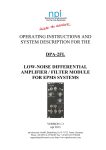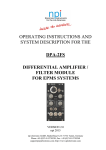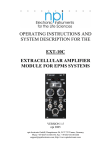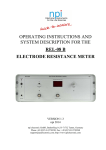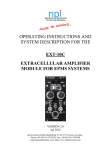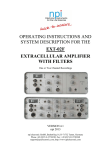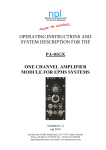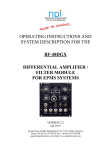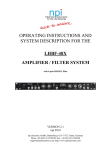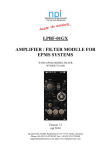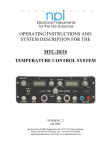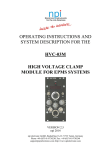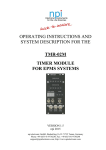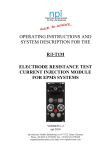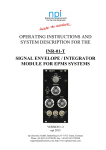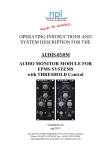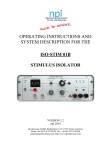Download DPA-2FX Manual - NPI Electronic Instruments
Transcript
OPERATING INSTRUCTIONS AND SYSTEM DESCRIPTION FOR THE DPA-2FX DIFFERENTIAL AMPLIFIER / FILTER MODULE FOR EPMS SYSTEMS VERSION 1.8 npi 2014 npi electronic GmbH, Bauhofring 16, D-71732 Tamm, Germany Phone +49 (0)7141-9730230; Fax: +49 (0)7141-9730240 [email protected]; http://www.npielectronic.com DPA-2FX User Manual ___________________________________________________________________________ Table of Contents 1. Safety Regulations ............................................................................................................ 3 2. EPMS-07 Modular Plug-In System .................................................................................. 4 2.1. General System Description / Operation ..................................................................... 4 2.2. EPMS-07 Housing ....................................................................................................... 4 2.3. EPMS-E-07 Housing ................................................................................................... 4 2.4. PWR-03D .................................................................................................................... 4 2.5. System Grounding ....................................................................................................... 5 EPMS-07 ..................................................................................................................... 5 EPMS-E-07.................................................................................................................. 5 2.6. Technical Data ............................................................................................................. 5 EPMS-07 ..................................................................................................................... 5 EPMS-E-07.................................................................................................................. 5 3. DPA-2FX Differential Amplifier / Filter Module ............................................................ 6 3.1. DPA-2FX Components................................................................................................ 6 3.2. System Description ...................................................................................................... 6 3.3. Signal Flow Diagram ................................................................................................... 6 3.4. Description of the Front Panel and Operation ............................................................. 7 4. Literature .......................................................................................................................... 10 5. Technical Data .................................................................................................................. 11 ___________________________________________________________________________ version 1.8 page 2 DPA-2FX User Manual ___________________________________________________________________________ 1. Safety Regulations VERY IMPORTANT: Instruments and components supplied by npi electronic are NOT intended for clinical use or medical purposes (e.g. for diagnosis or treatment of humans), or for any other life-supporting system. npi electronic disclaims any warranties for such purpose. Equipment supplied by npi electronic must be operated only by selected, trained and adequately instructed personnel. For details please consult the GENERAL TERMS OF DELIVERY AND CONDITIONS OF BUSINESS of npi electronic, D-71732 Tamm, Germany. 1) GENERAL: This system is designed for use in scientific laboratories and must be operated only by trained staff. General safety regulations for operating electrical devices should be followed. 2) AC MAINS CONNECTION: While working with the npi systems, always adhere to the appropriate safety measures for handling electronic devices. Before using any device please read manuals and instructions carefully. The device is to be operated only at 115/230 Volt 60/50 Hz AC. Please check for appropriate line voltage before connecting any system to mains. Always use a three-wire line cord and a mains power-plug with a protection contact connected to ground (protective earth). Before opening the cabinet, unplug the instrument. Unplug the instrument when replacing the fuse or changing line voltage. Replace fuse only with an appropriate specified type. 3) STATIC ELECTRICITY: Electronic equipment is sensitive to static discharges. Some devices such as sensor inputs are equipped with very sensitive FET amplifiers, which can be damaged by electrostatic charge and must therefore be handled with care. Electrostatic discharge can be avoided by touching a grounded metal surface when changing or adjusting sensors. Always turn power off when adding or removing modules, connecting or disconnecting sensors, headstages or other components from the instrument or 19” cabinet. 4) TEMPERATURE DRIFT / WARM-UP TIME: All analog electronic systems are sensitive to temperature changes. Therefore, all electronic instruments containing analog circuits should be used only in a warmed-up condition (i.e. after internal temperature has reached steady-state values). In most cases a warm-up period of 20-30 minutes is sufficient. 5) HANDLING: Please protect the device from moisture, heat, radiation and corrosive chemicals. ___________________________________________________________________________ version 1.8 page 3 DPA-2FX User Manual ___________________________________________________________________________ 2. EPMS-07 Modular Plug-In System 2.1. General System Description / Operation The npi EPMS-07 is a modular system for processing of bioelectrical signals in electrophysiology. The system is housed in a 19” rackmount cabinet (3U) has room for up to 7 plug-in units. The plug-in units are connected to power by a bus at the rear panel. The plug-in units must be kept in position by four screws (M 2,5 x 10). The screws are important not only for mechanical stability but also for proper electrical connection to the system housing. Free area must be protected with covers. 2.2. EPMS-07 Housing The following items are shipped with the EPMS-07 housing: EPMS-07 cabinet with built-in power supply Mains cord Fuse 2 A / 1 A, slow Front covers In order to avoid induction of electromagnetic noise the power supply unit, the power switch and the fuse are located at the rear of the housing. 2.3. EPMS-E-07 Housing The following items are shipped with the EPMS-E-07 housing: EPMS-E-07 cabinet External Power supply PWR-03D Power cord (PWR-03D to EPMS-E-07) Mains chord Fuse 1.6 A / 0.8 A, slow Front covers The EPMS-E-07 housing is designed for low-noise operation, especially for extracellular and multi channel amplifiers with plugged in filters. It operates with an external power supply to minimize distortions of the signals caused by the power supply. 2.4. PWR-03D The external power supply PWR-03D is capable of driving up to 3 EPMS-E housings. Each housing is connected by a 6-pole cable from the one of the three connectors on the front panel of the PWR-03D to the rear panel of the respective EPMS-E housing. (see Figure 1, Figure 3). A POWER LED indicates that the PWR-03D is powered on (see Figure 1). Power switch, voltage selector and fuse are located at the rear panel (see Figure 2). Note: The chassis of the PWR-03D is connected to protective earth, and it provides protective earth to the EPMS-E housing if connected. ___________________________________________________________________________ version 1.8 page 4 DPA-2FX User Manual ___________________________________________________________________________ Figure 1: PWR-03D front panel view Figure 2: PWR-03D rear panel view Note: This power supply is intended to be used with npi EPMS-E systems only. 2.5. System Grounding EPMS-07 The 19" cabinet is grounded by the power cable through the ground pin of the mains connector (= protective earth). In order to avoid ground loops the internal ground is isolated from the protective earth. The internal ground is used on the BNC connectors or GROUND plugs of the modules that are inserted into the EPMS-07 housing. The internal ground and mains ground (= protective earth) can be connected by a wire using the ground plugs on the rear panel of the instrument. It is not possible to predict whether measurements will be less or more noisy with the internal ground and mains ground connected. We recommend that you try both arrangements to determine the best configuration. EPMS-E-07 The 19" cabinet is connected to the PROTECTIVE EARTH connector at the rear panel. The chassis is linked to protective earth only if the PWR-03D is connected. It can be connected also to the SYSTEM GROUND (SIGNAL GROUND) on the rear panel of the instrument (see Figure 3). Important:: Always adhere to the appropriate safety measures. Figure 3: Rear panel connectors of the EPMS-E-07 2.6. Technical Data 19” rackmount cabinet, for up to 7 plug-in units Dimensions: 3U high (1U=1 3/4” = 44.45 mm), 254 mm deep EPMS-07 Power supply: 115/230 V AC, 60/50 Hz, fuse 2 A / 1 A slow, 45-60 W EPMS-E-07 External power supply (for EPMS-E): 115/230 V AC, 60/50 Hz, fuse 1.6/0.8 A, slow Dimensions of External power supply: (W x D x H) 225 mm x 210 mm x 85 mm ___________________________________________________________________________ version 1.8 page 5 DPA-2FX User Manual ___________________________________________________________________________ 3. DPA-2FX Differential Amplifier / Filter Module 3.1. DPA-2FX Components The following items are shipped with the DPA-2FX system: Amplifier / Filter module for the EPMS-07 system User manual 3.2. System Description The DPA-2FX differential amplifier/filter is a plug-in unit for the npi EPMS-07 modular system. The DPA-2FX is designed to amplify and filter small bio-electrical signals. The input voltage range is ±12 V, the inputs are protected up to 15 V. 2 overload-LEDs indicate if the linear region of the amplifier is exceeded. All inputs and the output are BNC connectors. The input impedance is 10 M. Thus, the module can be used for direct recording of bioelectric signals, e.g. from peripheral nerves. Using the differential input configuration common mode signals and noise are removed allowing recordings of signals with small amplitudes. DC offsets of the signal can be compensated either by the using the OFFSET control or they can be eliminated using the AC position of the input switches or by using the HIGHPASS filter. DC offsets from the amplifier can be corrected by two trimpots. The GAIN range is x1 to x10000 and can be set with two switches (1-2-5-10-20-50-100 rotary switch and 1-10-100 range switch). The output signal is passed through the HIGHPASS and LOWPASS filter. Important: To avoid noise interference the respective toggle switch should be in the zero position if one of the inputs is not used. 3.3. Signal Flow Diagram The signal is passed through the DPA-2FX as shown below. ___________________________________________________________________________ version 1.8 page 6 DPA-2FX User Manual ___________________________________________________________________________ 3.4. Description of the Front Panel and Operation Figure 4: DPA-2FX front panel view ___________________________________________________________________________ version 1.8 page 7 DPA-2FX User Manual ___________________________________________________________________________ In the following description of the front panel elements each element has a number that is related to that in Figure 4. The number is followed by the name (in uppercase letters) written on the front panel and the type of the element (in lowercase letters). Then, a short description of the element is given. Signal OFFSET unit The OFFSET unit consists of (1) OFFSET range switch and (2) OFFSET potentiometer. (1) OFFSET range switch 3-position switch for selecting the OFFSET range, 0.1 V, 1 V or 10 V. (2) OFFSET potentiometer 10-turn potentiometer for compensating for a DC OFFSET. Note: The overall OFFSET compensation is the product of the reading of both controls. Important: Position 5 of the OFFSET potentiometer corresponds to 0 mV offset. The offset compensation only works if the input coupling switch is set to DC. If the HIGHPASS FILTER is used, the OFFSET control is disabled. GAIN unit The GAIN unit consists of (3) GAIN range switch and (4) GAIN factors switch. (3) GAIN range switch 3-position rotary switch for selecting the GAIN range, x1, x10 or x100. (4) GAIN factor switch 7-position rotary switch for selecting the GAIN factor, x1, x2, x5, x10, x20, x50 or x100. Note: The overall GAIN is the product of the reading of both controls. ___________________________________________________________________________ version 1.8 page 8 DPA-2FX User Manual ___________________________________________________________________________ Filter unit The filter unit consists of (5) LOWPASS filter and (12) HIGHPASS filter. (5) LOWPASS filter Single pole LOWPASS filter with 6 dB / octave. Corner frequencies: 30, 100, 300, 500, 700, 900, 1.3k, 1.5k, 1.7k, 3k, 10k, 20k Hz. (12) HIGHPASS filter Single pole HIGHPASS filter with 6 dB / octave. Corner frequencies: 3, 30, 100, 300, 400, 500, 600, 800, 1k, 3k, 10k Hz. In OFF position the filter is disabled. Note: By combining HIGH- and LOWPASS filters, a filter with bandpass characteristic can be implemented easily. (6) + OVER, - OVER LEDs LEDs indicating that the DPA-2FX exceeds it’s linear range (10 V). (7) OUT connector BNC connector providing the conditioned signal. (8, 9) – IN, + IN connector BNC connectors for connecting the input signal. The inputs can be used in single ended or differential configuration. In differential configuration the signal which is connected to –IN is subtracted from the signal that is connected to +IN. If only one input is used (single ended configuration) the other should be grounded to avoid coupling of noise. (10, 11) input coupling switches The position of the input coupling switch decides how the input signal is coupled: AC: DC: 0: the input signal is AC coupled with a corner frequency of 0.1 Hz the input signal is DC coupled the input signal is grounded. ___________________________________________________________________________ version 1.8 page 9 DPA-2FX User Manual ___________________________________________________________________________ (13) GAIN ZERO ADJ. trimpots Trimpots to compensate for amplifier offsets. If the baseline is not zero even if the input is grounded, this offset can be compensated independently for the two GAIN stages. Compensation procedure: Set the input coupling switches to zero to ground the inputs, and set the HIGH PASS FILTER to 400 Hz. Set the GAIN range switch to 1, the GAIN factor switch to one and adjust the baseline to zero using the left trimpot. Switch the GAIN factor switch to all positions and readjust to zero if necessary. Set the GAIN range switch to 10. If an offset is present, compensate it using the right trimpot. Set the GAIN range switch to 100 and readjust the baseline if necessary. 4. Literature Barmashenko, G., Eysel, U. T., & Mittmann, T. (2003). Changes in intracellular calcium transients and LTP in the surround of visual cortex lesions in rats. Brain Res. 990, 120128. Boulton, A. A., Baker, G. B. & Vanderwolf, C. H. (eds.) (1990). Neurophysiological Techniques, Basic Methods and Concepts. Humana Press, Clifton, New Jersey. Huemmeke, M., Eysel, U. T., & Mittmann, T. (2002). Metabotropic glutamate receptors mediate expression of LTP in slices of rat visual cortex. Eur.J.Neurosci. 15, 1641-1645. Huemmeke, M., Eysel, U. T., & Mittmann, T. (2004). Lesion-induced enhancement of LTP in rat visual cortex is mediated by NMDA receptors containing the NR2B subunit. J Physiol 559 , 875-882. Schulz, D., Huston, J. P., Jezek, K., Haas, H. L., Roth-Harer, A., Selbach, O., & Luhmann, H. J. (2002). Water maze performance, exploratory activity, inhibitory avoidance and hippocampal plasticity in aged superior and inferior learners. Eur.J.Neurosci. 16, 21752185. Kettenmann, H. & Grantyn, R. (eds.) (1992). Practical Electrophysiological Methods. Wiley-Liss, New York Lalley, P.M., A.K. Moschovakis and U. Windhorst (1999) Electrical Activity of Individual Neurons In Situ: Extra- and Intracellular Recording, in: U. Windhorst and H. Johansson (eds.) Modern Techniques in Neuroscience Research, Springer, Berlin, New York Müller, Ch.M. (1992) Extra- and Intracellular Recording in the Slice, in: Kettenmann, H. & Grantyn, R. (eds.) Practical Electro-physiological Methods, Wiley-Liss, New York Ogden, D. (ed.) (1992) Microelectrode Techniques - The Plymouth Workshop Handbook, Second Edition, The Company of Biologists Ltd., Cambridge Seidenbecher, T. and H.C. Pape (2001) Contribution of intralaminar thalamic nuclei to spike-and-wave-discharges during spontaneous seizures in a genetic rat model of absence epilepsy, European Journal of Neuroscience, Vol. 13:1537-1546 Windhorst, U. and H. Johansson (eds.) (1999) Modern Techniques in Neuroscience Research, Springer, Berlin, Heidelberg, New York ___________________________________________________________________________ version 1.8 page 10 DPA-2FX User Manual ___________________________________________________________________________ 5. Technical Data DPA-2FX Input range: ±12 V; protected up to 15 V Input impedance: 10 M, related to ground Input capacitance: 30 pF AC coupling at input: corner frequency of 0.1 Hz (if AC / 0 / DC-switch at BNC connector is switched to AC) OFFSET compensation: set by ten-turn potentiometer, range 0.1, ±1 V or ±10 V set by toggle switch HIGHPASS Filter: single pole, attenuation: -6 dB / octave, corner frequencies (Hz): 3, 30, 100, 300, 400, 500, 600, 800, 1k, 3k, 10k LOWPASS Filter: single pole, attenuation: -6 dB/octave, corner frequencies (Hz): 30, 100, 300, 500, 700, 900, 1.3k, 1.5k, 1.7k, 3k, 10k, 20k GAIN: rotary-switch 1-2-5-10-20-50-100 GAIN range: selectable with rotary switch x1, x10, x100 Overload LEDs: starting to light up at ±10 V Output: range: ±12 V into 1 k / ±1 V into 50 Size: front panel 12 HP (60.6 mm) x 3U (128,5 mm), 7” (175 mm) deep EPMS-07 SYSTEM Power requirements: 115/230 V AC, 60/50 Hz, fuse 2 A / 1 A, slow, 45-60 W (dependent on the modules plugged in) Dimensions: 19” rackmount cabinet, 3U high (1U = 1 ¾” = 44.45 mm) ___________________________________________________________________________ version 1.8 page 11











